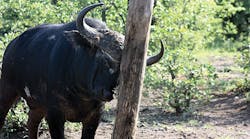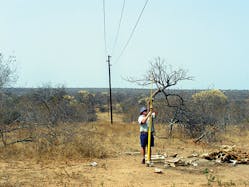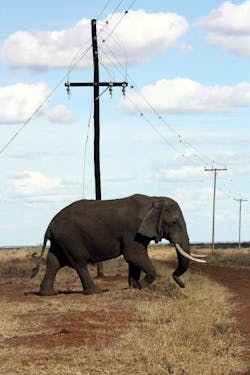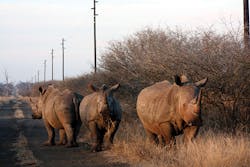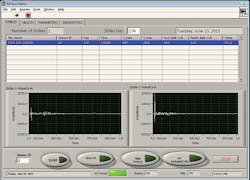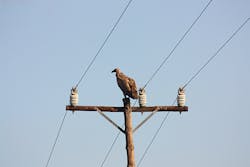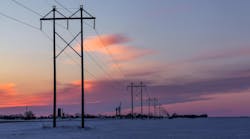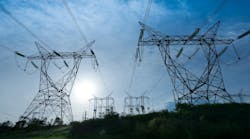Ever since the first power lines were built, there has been a continuous problem of wildlife interactions with these prominent components of electrical infrastructure. In Africa, the problem is often accentuated because of the sheer size and diversity of the species, which can range from the electrocution of large mammals, such as elephants, giraffes and rhinoceroses, to sociable weaver birds building nests on the poles themselves — nests that can weigh more than a ton.
The utility in South Africa, Eskom, is responsible for the generation, transmission and distribution of electricity across the country as well as for providing electricity to neighboring countries Botswana, Mozambique, Zimbabwe and Namibia. Like any utility, Eskom is responsible for providing a high-quality supply of electricity to meet the ever-increasing needs of its customers. As a result, its infrastructure of power lines and substations is continuously expanding to support annual load growth. The challenge for Eskom is to find balance among the interests of industry, the residential electrification program, and the effective use and conservation of natural resources.
In view of the complexity, scope and persistence of the problem of interactions between wildlife and power lines, Eskom and the Endangered Wildlife Trust (EWT) formalized a long-standing relationship by entering into a partnership in 1996. The goal was to address the wildlife problems in a systematic manner on a national basis and to establish an integrated management system to minimize negative wildlife interactions.
The partnership strives to achieve five objectives:
• Investigate reported wildlife-related incidents with electricity infrastructure and on Eskom-owned properties
• Maintain a national central incident register for all wildlife interactions
• Mainstream biodiversity into the Eskom business, through specialist advice on the latest trends, biodiversity management practices and biodiversity networking, and through input into the Eskom biodiversity strategy
• Research and design mitigation measures to reduce negative wildlife interactions
• Raise awareness through effective communication among Eskom employees and the general public on the issue of wildlife interactions with electricity infrastructure and on Eskom-owned properties.
Partnership Benefits
The Eskom–EWT partnership has become an integral part of the utility’s business and operations, and is considered by many to be a world leader in this field. The partnership has mutual benefits to both organizations with the EWT achieving its objective of promoting biodiversity conservation and Eskom achieving the following benefits:
• Improved business performance with fewer line faults and organization risks as a result of wildlife interactions
• Expertise and knowledge transfer with more than 9,000 Eskom staff trained on wildlife interactions over the past two years
• Goodwill, as the program acts as an early warning system and proactively addresses issues that could otherwise lead to negative publicity
• Cost effectiveness, as the EWT’s extensive network of volunteer field workers is doing the bulk of field investigations and data gathering at minimal cost to Eskom.
Neighboring Countries
Africa’s population and economy continue to grow at a fast pace, thus increasing the demand for electricity. In response, the Eskom–EWT partnership has taken on a leadership role in neighboring countries such as Namibia to showcase its collaboration as a model for strategic partnerships between local utilities and conservation entities.
To share knowledge and experience in a mutually beneficial manner, the EWT recently hosted biologists from the NamPower–Namibia Nature Foundation strategic partnership to showcase wildlife mitigation accomplished in South Africa’s world-renowned Kruger National Park. Established in 1898 to protect the wildlife of the South African Lowveld, Kruger National Park has an unrivaled diversity of life forms, including 507 bird species and 147 mammal species, fused with historical and archaeological sites from bushman rock paintings to archaeological sites like Masorini and Thulamela.
The interaction between man and the environment within Kruger National Park is more evident today than ever before, with millions of tourists visiting the park on an annual basis. Although most of these people are keen conservationists, the requirements of an international attraction also negatively impact the environment, as electricity supplies are required in the majority of the 23 tourist camps within the park.
Rubbing Posts
The visit to Kruger National Park with the Namibian biologists was coordinated to give the EWT an opportunity to showcase completed bird collision and animal electrocution studies that were conducted to investigate both the impact of electrical infrastructure on wildlife and the impact of wildlife on electrical infrastructure.
For example, animals in the Kruger National Park were using some of the poles as rubbing posts, which results in these poles having to be replaced as often as every six months, because a broken pole can affect supply and also cause conductors to sag to the ground, posing an electrocution threat to both birds and animals. As the lines in the park stretch over long distances, locating and replacing a pole can become a costly and dangerous exercise.
Initially, rhinos were thought to be the primary culprits using the poles as rubbing posts, taking away the outer layer of creosote used to protect the pole and allowing termites and other insects to enter the pole, making it brittle. Attempts to thwart rhinos by piling rocks at the pole bases were ineffective; subsequently, the Eskom–EWT partnership used camera traps to record video and still photography of the mammal interactions.
The study concluded rhinos comprised 26% of all the interactions, whereas Cape Buffalo made up 36%, elephant 4% and all other species combined made up the remaining 34%. The interaction between the large mammals and the poles also varied dramatically depending on the areas through which the power lines traverse. The images showed Cape Buffalo, the mammal having the biggest impact on the wooden poles, used their cloven hooves to move freely between the piles of rocks to get to the poles.
Since the study, three new mitigation methods have been tested successfully. This is a prime example of how biologists and engineers can work together to resolve animal conflicts effectively.
Power Line Collisions
Two new investigations along power lines with a history of collision problems also were conducted with the Namibian biologists. These lines were previously marked with swinging plates, and the investigations were conducted to collect additional data on wire marking effectiveness. The surveys revealed a kori bustard bird collision at the first investigation. The kori bustard is Africa’s largest flying bird and classified as a near-threatened species by the International Union for Conservation of Nature (IUCN). These species also are in Namibia. The second investigation yielded two kori bustards and one vulture.
Both of these events occurred on compact delta distribution power line structures that had been marked and were highly visible, suggesting the birds may have been flushed from the service road below. Kori bustards are particularly prone to collisions with power lines because of their size. As the world’s largest and heaviest flying bird, they are slower at maneuvering power lines and often cannot redirect their flight path in time.
EDM International participated in the power line surveys. EDM was invited by the Eskom–EWT partnership to demonstrate its Bird Strike Indicator (BSI). The partnership requested the demo because of its concerns about ongoing power line collisions in Namibia with greater flamingos, blue cranes (IUCN vulnerable species) and kori bustards.
The BSI is an automated vibration-sensing and recording tool designed to detect bird strikes on aerial cables such as power lines and guy wires. With technology developed by the Electric Power Research Institute and the California Energy Commission, the BSI provides utilities the ability to identify the most dangerous line segments and determine the effectiveness of line marking devices.
The BSI uses accelerometers to record stress waves and vibrations caused by a bird strike. Its sensors are installed on the monitored wires and transmit strike activity wirelessly to a nearby base station where the data is recorded. BSI monitors can be installed on energized lines and will operate in all weather conditions. Research using the BSI has demonstrated it is as reliable as human observers at detecting collisions and offers the advantage of providing continuous data recording, even in the most remote locations. Data retrieval and changes to BSI settings also can be performed remotely.
Transforming the Future
As more power lines are constructed throughout Africa, it will be important to ensure that lessons learned in South Africa will not be lost. For more than 100 years, Africa’s wildlife and natural beauty have been attracting tourists, and they are an important part of many African countries’ economies. Thus, building power lines in an animal-friendly manner creates a great opportunity to capitalize on ecotourism to ensure citizens living in the areas being visited are benefiting from the economic growth. Additionally, building lines in such a manner will improve business performance with fewer line faults.
In the end, the hope is the Eskom–EWT partnership will help to transform new infrastructure processes in neighboring countries such as Namibia and throughout the world.
Constant Hoogstad ([email protected]) has worked as head guide at lodges in the Lowveld Kruger National Park area and has worked in wildlife research focusing on the feeding behavior of carnivores. He also is experienced in reserve management. Hoogstad has been with the Endangered Wildlife Trust for the last five years as manager of the wildlife and energy program and the EWT–Eskom partnership. He is currently pursuing a master’s degree on vultures through Wits University.
Rudi Kruger ([email protected]) is a corporate environmental specialist employed by Eskom. He holds a master’s degree in environmental management and specializes in wildlife interactions with electrical infrastructure. Over the past 33 years, Kruger has performed various investigations and research on wildlife interactions and presented the results at various seminars.
Rick Harness ([email protected]) is a wildlife biologist with EDM International Inc. Harness specializes in wildlife-utility interactions, including power line electrocutions and bird collisions. He has completed more than 50 avian protection plans from Alaska to Florida, developing plans for investor-owned utilities, electric cooperatives, municipalities, the U.S. Fish and Wildlife Service and military bases. He also has worked on these issues in Mongolia, Hungary, Israel, Mexico and South Africa. Harness also works with manufacturers to develop new products to reduce avian electrocutions and collisions.
